So far, I’ve written four articles about Denmark’s Purifi Audio and their products. The first, “Audio Video Show 2019: Coffee with Peter Lyngdorf,” was published in November 2019 on SoundStage! Global, while I was attending the annual show in Warsaw, Poland. That conversation with hi-fi entrepreneur Lyngdorf was when I first got intrigued about his new venture, Purifi Audio, and the company’s products.
In June 2020 came my second piece, “Purifi Audio’s Pint-Sized Powerhouses.” There I described in detail the company’s first two products, the 1ET400A amplifier module and the PTT6.5W04 midrange-woofer driver, as well as two product-evaluation samples I’d been sent: the SPK5 loudspeaker and the Eigentakt stereo amplifier, the latter comprising two 1ET400A modules. “The Purifi Puzzle, Part One: The Measured Performance of the Eigentakt Amplifier” appeared in September 2020. This present article focuses on the measured performance of the SPK5 loudspeaker, which uses a single PTT6.5W04 drive-unit.
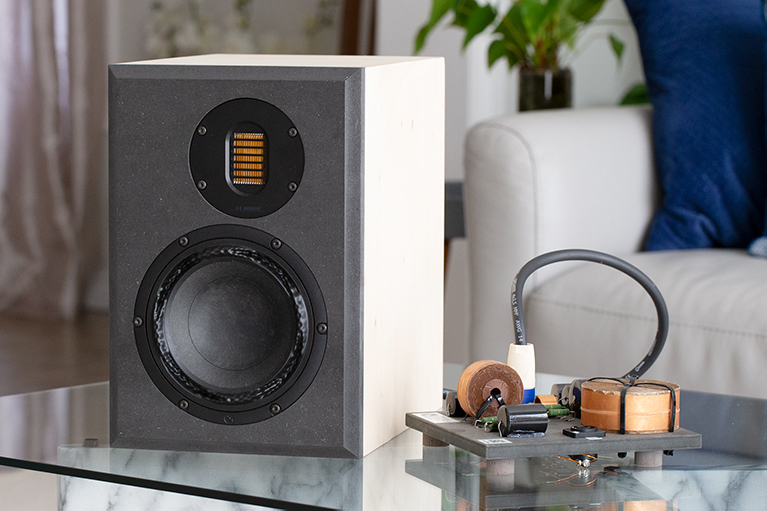
Purifi is for parts
As mentioned in my three previous articles, Purifi Audio doesn’t make commercial hi-fi products -- you can’t order an Eigentakt amplifier or a pair of SPK5 loudspeakers from a dealer or online retailer, or even from Purifi itself. (The company does publish the details of both designs on their website -- if you have the skills, you could build them yourself.) Instead, Purifi is an original equipment manufacturer, or OEM, whose products are designed to be used by other companies in those latter companies’ final commercial products. Currently, Purifi makes the 1ET400A amplifier module, three speaker drive-units -- the PTT6.5W04, PTT6.5W08, and PTT4.0W4 -- and the PTT6.5PR passive radiator. A Google search turned up these companies currently using Purifi amps in their electronics: Appollon Audio, LKV Research, NAD, and Nord Acoustics. Purifi drivers are currently used in various speaker models made by the Joachim Gerhard Collection, Selah Audio, and Wayne Jones Audio. There may be more, and undoubtedly there will be -- Purifi is still pretty new.
Because Purifi doesn’t make commercial products, the audible and measured performances of their Eigentakt amplifier and SPK5 speaker won’t necessarily reflect the performance of amps and speakers made by other companies using these OEM units -- there’s a lot more to any finished commercial product than one or two parts. Product designers also often put their own spins on an OEM device, to make it stand out in a crowded marketplace -- any of those changes might affect the sound.
But the sounds of the Eigentakt and SPK5 that I described in June, and our measurements of them as published in September and now here, still serve a purpose: They indicate how the Purifi designers think the 1ET400A and PTT6.5W04 could be implemented in a final product. As a result, the Eigentakt and SPK5 can be considered yardsticks for comparison.
Measurements, claims, caveats
This slogan appears on Purifi Audio’s website: “Pure Sound: Building a Straight Wire to the Soul of Music.” My conversations with founder Lyngdorf, CEO Claus Neesgaard, and designers Lars Risbo and Bruno Putzeys have made clear to me that by this they mean that their products add no audible colorations to the reproduction of recorded sound. They also said this another way, claiming that their 1ET400A amplifier and PTT6.5W04 driver produce a neutral frequency response, with no part of the audioband emphasized or deemphasized, and with distortion so low it can be detected only with the best measuring tools.
Thankfully, at SoundStage! we have access to a great measuring facility and tools. We measured the Eigentakt amplifier using an Audio Precision APx555, widely considered the best audio analyzer for its intrinsically low noise and distortion. As described in my September article, the Eigentakt amp met Purifi’s claims: power outputs of >200Wpc into 8 ohms or >400Wpc into 4 ohms; ruler-flat frequency response within the audioband of 20Hz-20kHz, regardless of load; extraordinarily low levels of total harmonic distortion plus noise (THD+N) and intermodulation distortion (IMD) within its rated power outputs; etc.
We measure loudspeakers in the anechoic chamber of Canada’s National Research Council (NRC), in Ottawa. As good as it is, this chamber has limitations in terms of accurate measurements of a speaker’s bass output below about 100Hz. (To accurately measure bass output down to 20Hz, you’d need a chamber big enough to hold four large bulldozers.) But, like the Audio Precision APx555, the NRC’s chamber has a very low noise floor that allows us not only to reliably and repeatably measure a speaker’s frequency response above 100Hz, but also to measure its distortion to below 1%.
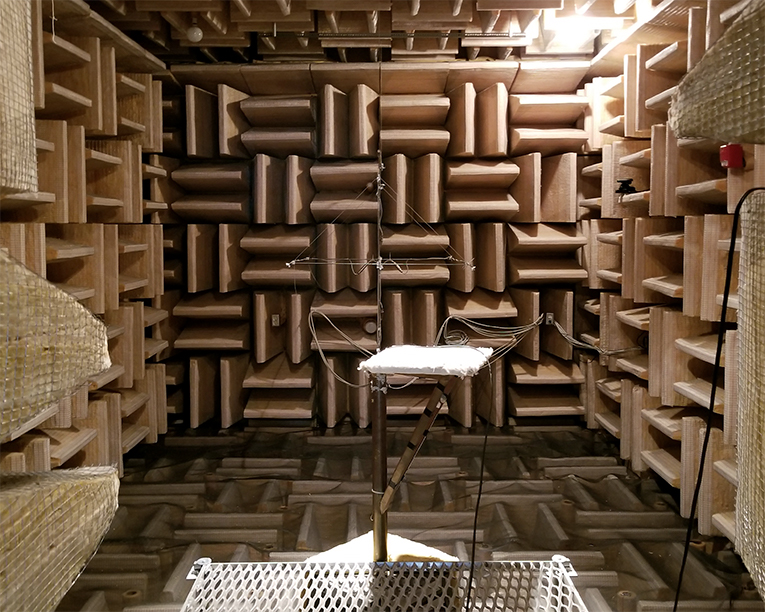
Caveat: Purifi claims low THD+N and IMD, but we couldn’t verify the latter -- the software we use measures only THD+N. Still, the THD+N measurements plotted below go a long way toward confirming Purifi’s claim that the SPK5 is a transducer that produces ultra-low levels of distortion, even at very high sound-pressure levels (SPLs).
Understanding our measurements of the SPK5
As I described in June, Purifi’s SPK5 has a basic enclosure made mostly of unfinished, roughly joined plywood. Its front panel is crude, but is by far the best-finished thing about it: MDF painted gray, with generously chamfered edges to reduce diffraction. On the SPK5’s rear is a large plastic flange that acts as an exit for the tube that snakes through the inside.
In addition to the PTT6.5W04 midrange-woofer, the SPK5 has a Mundorf AMT21CM2.1 Air Motion Transformer (AMT) tweeter. The two drivers are crossed over to each other at 3.2kHz -- in the graphs below, the PTT6.5W04’s behavior is mostly indicated by everything below that crossover frequency of 3.2kHz, and the AMT21CM2.1’s behavior by everything above it. The external crossover, designed by Purifi, includes resistors, inductors, and capacitors from Janzen. The wires connecting crossover to speaker and crossover to amplifier were Cordial cables.
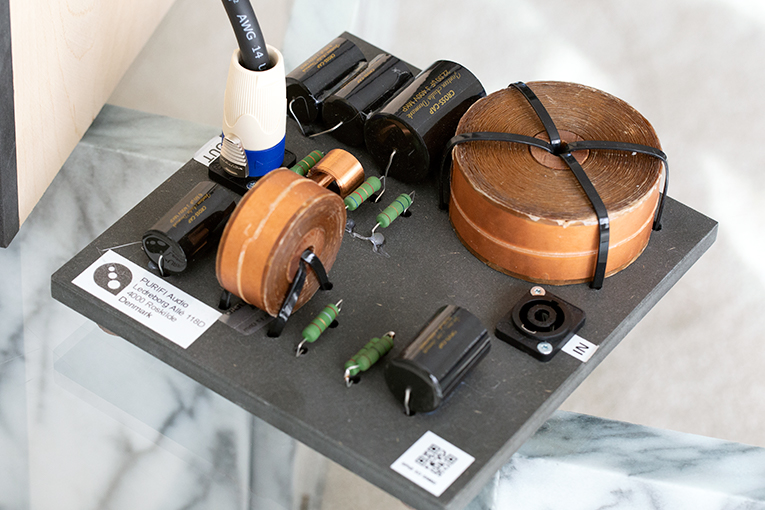
The SPK5’s tweeter is mounted above and to one side of the woofer, the two speakers of one evaluation kit being mirror-imaged. For my listening, I set up the speakers so that their tweeters were closer to the inner edges of their cabinets, for the best imaging. We measured the speaker I’d used for the left channel. This will be relevant if you visit our measurement page for the SPK5 (see below) and look at the measurements taken at 15°, 30°, 45°, 60°, and 75° off the tweeter axis. We measured that speaker because, given how we usually turn a loudspeaker in the anechoic chamber, those off-axis measurements show you the acoustic energy that would be directed toward the wall closest to the speaker -- i.e., the first-reflection point, or the first surface the soundwaves generated by the tweeter encounter and bounce off of.
When we measure a speaker in the NRC’s anechoic chamber, we place it on a platform that places it 2 meters from the main measuring microphone. Four secondary measuring mikes are hung nearby to take the off-axis measurements at the 15° intervals mentioned above. For the SPK5, the main mike was pointed at the lateral center of the front baffle, at the height of the center of the AMT’s diaphragm.
At first I’d planned to limit the SPK5’s measurements to the four graphs reproduced below, which tell the story of the speaker’s linearity and distortion. Instead, we ran the SPK5 through the full battery of tests to which we subject every speaker we review, and which you can find on our SoundStage! Network portal site. This will give more information about the SPK5, and a fuller comparison of its measured performance to those of the other speakers we’ve tested in the last two decades.
Frequency response
We call the graph below a speaker’s Listening Window: an average of five frequency-response measurements taken between 20Hz and 20kHz, the lower and upper limits of the audioband -- i.e., the maximum range of frequencies that humans can hear. The measurements are taken on axis, as well as 15° horizontally, both left and right, and 15° vertically off axis, above and below the main axis (the four other mikes). We average the results of these five measurements and display them as a single trace because the NRC’s past research has demonstrated that the average represents a speaker’s direct output as heard by a listener better than does a single on-axis measurement. Another thing: Although the measurements are taken at a distance of 2m, to give the drivers’ outputs time to integrate better, they’re mathematically adjusted and plotted for a distance of 1m -- the latter distance being the standard long ago agreed on by the audio industry.
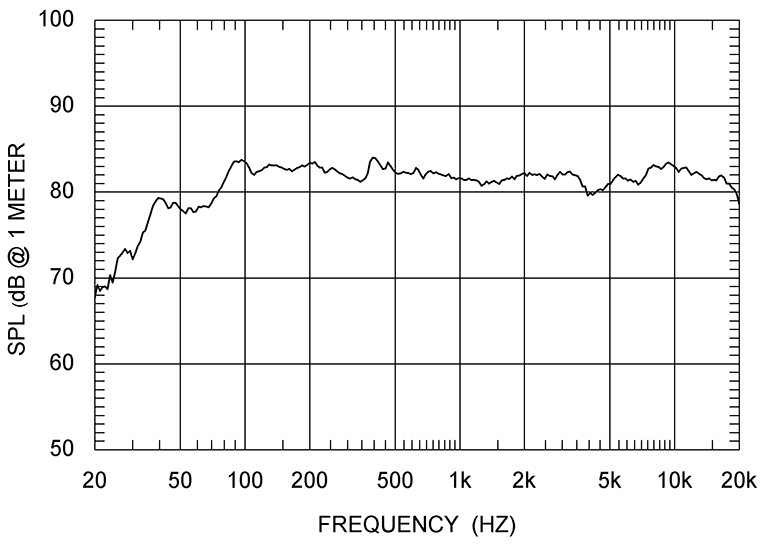
When looking at the Listening Window, the first thing to understand is what’s happening below 100Hz: the bass. You can see the trace drop rapidly at about 90Hz, then rise to a small peak at about 40Hz. This, for good reason, looks odd to many people. But this sort of plot represents the anechoic behavior of every rear-ported speaker we’ve measured, for a reason . . .
The SPK5’s port is tuned to about 52Hz, the frequency around which the port is outputting most of the bass. The port’s output supplements the woofer’s drooping output. However, the port’s contribution isn’t represented in the graph because the measurement mikes are in front of the speaker, the port is around back, and the anechoic chamber’s walls absorb most of the port’s output. But if we were to directly mike and measure the port, and add that to the midrange-woofer’s output as measured from the front, then you’d see the bass output tail off more evenly, without the sudden droop.
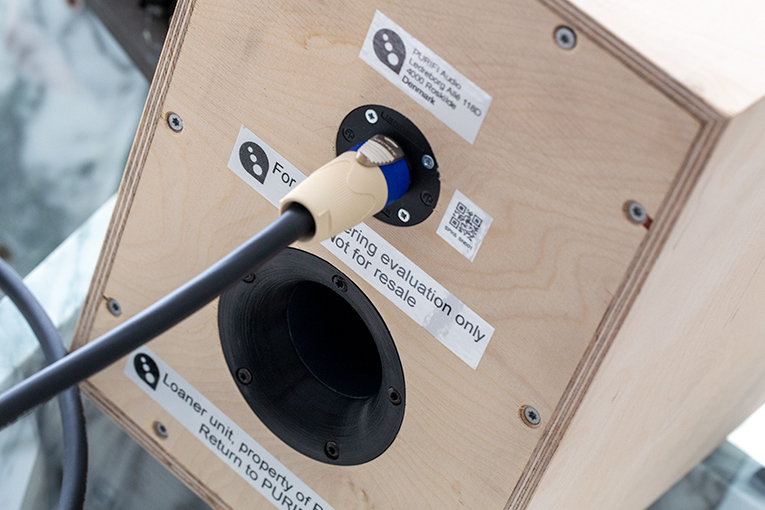
As I mentioned, the NRC’s anechoic chamber isn’t as accurate below 100Hz as above. To compensate for that, we apply a correction algorithm to the figures we plot, but the result still isn’t 100% accurate -- our measurements will tell you only so much about any speaker’s bass performance. Still, this Listening Window clearly shows that the SPK5 has respectable output at about 30Hz, the frequency at which the output is about 10dB below the peak output at 100Hz. For a small two-way speaker, that’s impressive bass extension.
The frequency range above 100Hz is far more accurate, and illustrates just how flat the total combined responses of the PTT6.5W04 midrange-woofer and AMT21CM2.1 tweeter are. Still, as is usual with loudspeakers, it’s not the perfectly straight line you’d see if measuring an amplifier -- little peaks and valleys appear throughout the audioband. The highest peak is at about 400Hz, at exactly 84dB -- within the PTT6.5W04’s operating bandwidth. The lowest dip is to just below 80dB, at about 4kHz, a frequency reproduced mostly by the AMT21CM2.1. Taking into account these highs and lows, it’s safe to say that this graph reveals that the SPK5’s frequency response is within ±2.1dB of flat or neutral response from 100Hz to 20kHz -- most loudspeakers are specified to within ±3dB. And with just a bit more work to mitigate the tiny peaks and valleys (I outline a possible reason for the 400Hz peak in the distortion measurements below), this speaker might easily get to under ±2dB or even ±1.5dB within this frequency range, which comprises nearly all of the audioband -- an outstanding result.
This graph reveals another important thing about the SPK5: its low sensitivity. Based on how we calculate sensitivity, using the five averaged measurements that comprise the Listening Window and averaging the data points between 300Hz and 3kHz, the sensitivity comes to about 82dB/2.83V/m. In the 20 years we’ve measured speakers using NRC’s chamber and methods, we’ve found that 87dB/2.83V/m is an average sensitivity for loudspeakers -- which makes the SPK5’s 82dB considerably lower. But it’s also important to note that sensitivity does not indicate sound quality; instead, it mainly indicates how much power is needed to generate a given SPL. The SPK5’s sensitivity doesn’t necessarily indicate the sensitivities of the PTT6.5W04 and AMT21CM2.1 drive-units themselves -- Purifi claims 88.5dB for the PTT6.5W04, Mundorf 93dB for the AMT (both at 2.83V/m). It’s Purifi’s design of the SPK5 that results in the speaker’s sensitivity being so low. Other designers using these same drivers might make different choices, depending on their priorities, which could result in higher overall sensitivity.
Total harmonic distortion plus noise (THD+N)
When we measure a loudspeaker’s THD+N, the speaker sits on the same platform in the anechoic chamber, 2m from the main measuring mike -- the only mike needed for this measurement, because only an on-axis reading is required. A series of stepped sinewave sweeps from 20kHz down to 50Hz is sent through the speaker to produce a prescribed average SPL, while an analyzer checks the mike feed for distortion products. (Again, our sweeps go down only to 50Hz because of the chamber’s bass inaccuracies; going any lower would generate meaningless results.)
The graph below shows the SPK5’s distortion at an average output level of 90dB, the typical level at which we test small, stand-mounted speakers such as this. This level is quite loud -- 90dB at a measurement distance of 2m is equivalent to 96dB at 1m (each halving of distance increases the perceived output by 6dB). And remember, only one speaker is playing. When two speakers are playing in a typical listening room, the overall output increases by about 3dB, and the room itself adds another 2-3dB. Since most people using two speakers in a real room listen at levels below 90dB, you can see how getting a single speaker to produce 90dB in an anechoic chamber requires that speaker to work very hard indeed.
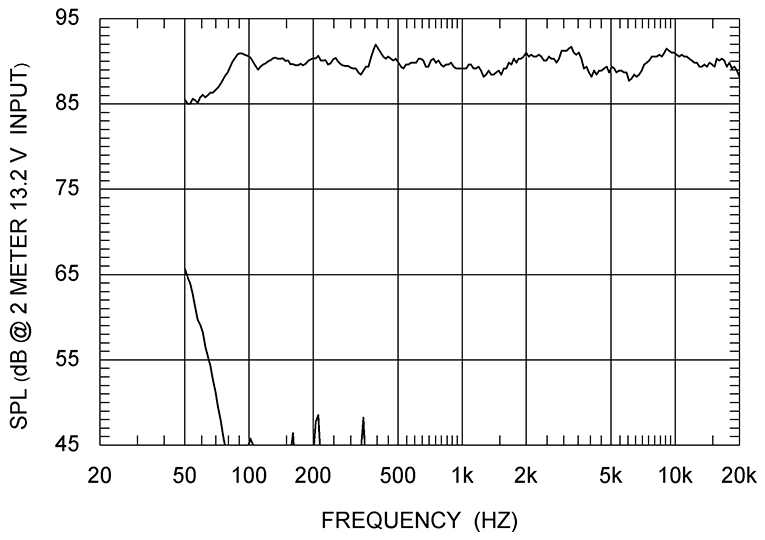
The top trace in this graph, indicating the SPL produced by the loudspeaker, hovers around 90dB. The spikes at the bottom indicate distortion products rising from the noise floor of the chamber. At about 100 and 160Hz, the smallest hints of distortion are visible -- you have to look close to see them. There are more prominent spikes at just over 200Hz and at about 350Hz, but even these are more than 40dB below the main signal level -- this translates to less than 1% distortion, which is very low. Above 350Hz, no distortion is visible. What’s interesting about the smallest visible spikes is that they don’t look like the typical driver distortion seen over the years, which is usually wider and more spread out. Instead, they look attributable to other common causes of such distortion, such as cabinet resonances, loose wiring, even port resonances. Without a more thorough investigation, it’s hard to know for sure.
From 80Hz down, however, the distortion rises steeply until it hits a peak at our lower limit of 50Hz. But, like the distortion products above, this rise in distortion is not strictly due to the PTT6.5W04 itself -- it’s mostly a result of the port, which we’ve seen with many speakers before. Ports are inherently noisy, and therefore, prone to distortion. But overall, even the port noise isn’t that bad -- and overall, the SPK5’s level of distortion from 50Hz to 20kHz is excellent for any small two-way speaker.
What’s not so obvious in this graph is how this graph’s vertical or Y axis is labeled: “13.2V INPUT,” the voltage required to conduct this test. That’s a very high voltage for a speaker, necessitated by the SPK5’s low sensitivity. To achieve an output level of 90dB, most speakers need less than 10V.
Having that high a voltage level for our 90dB test wasn’t a problem -- we knew it probably wouldn’t damage the SPK5 -- but it became a concern when we moved to the next test: the SPK5’s THD+N at 95dB. Beforehand, the computer had estimated that we’d have to input up to 24V! That’s far more than we were comfortable with -- we know from experience that the tweeters of many speakers suffer damage when they’re injected with more than 13V. Had we been measuring a typical loudspeaker, we’d have stopped our test right there and called it a day -- our goal is to measure a speaker’s performance, not break it.
But to test Purifi’s claims for the SPK5, we had to stress the speaker beyond normal operating limits. So we measured it at 95dB -- extremely loud, and a beyond-reasonable SPL for any small two-way speaker to reproduce. Sure enough, as the computer predicted, and as shown in the graph below, the SPK5 needed a whopping 23.8V to produce an SPL of 95dB -- far more volts than we’d ever put into any speaker. I didn’t expect either SPK5 driver to survive -- but both did, which allowed us to complete the measurements.
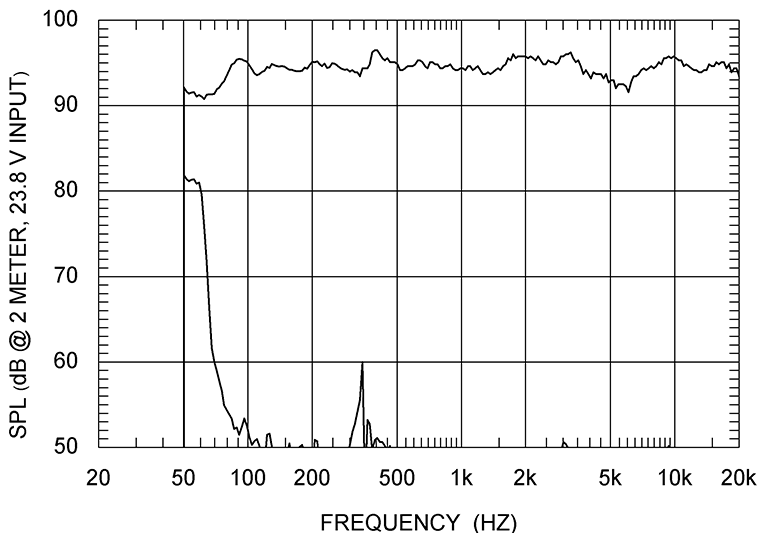
As expected, the SPK5’s distortion below 100Hz rose significantly, again mostly due to the port. There are some small hints of distortion from 100Hz to just over 200Hz, and then a very small bump at 3kHz, right at the crossover frequency. But again, these are considerably more than 40dB below the main signal level, and thus well below 1% distortion: negligible.
The elephant in the room is what happens at 350Hz -- the distortion there rose to quite a peak, though it’s still 35dB below the main signal level (2% distortion). There are also two smaller spikes above it in frequency (to the right in this graph) that don’t look like the distortion spikes from driver motors or cone problems that we’ve seen in all the distortion charts we’ve produced over the last 20 years, which makes me think they must be the results of something else the SPK5 is doing. I showed this graph to Lars Risbo at Purifi Audio, who was also curious about its cause; as I write this, he’s looking into what it might be. I can’t help wondering if his findings will end up being related to the slight bump in the frequency response that is around 400Hz.
Even with that larger spike at 350Hz, the measured performance of the PTT6.5W04 in the SPK5 is exemplary -- its ability to withstand such a punishing test while exhibiting such low distortion with so high an input voltage deserves nothing but praise. And if you look at the topmost frequencies, the AMT21CM2.1 also held together extremely well, other than a tiny bump at 3kHz. However, our next test shows that, despite its low distortion, Mundorf’s AMT didn’t do as well as it first appeared to.
Deviation from Linearity
Another of the tests we perform, Deviation from Linearity, tends to torture many drivers. In fact, some speaker makers have criticized it for thermally stressing drivers beyond practical limits, and thus restricting the test’s usefulness. The test involves sweeping a tone from 20kHz to 50Hz at 70dB to establish a baseline frequency response, then more sweeps at increasing output levels, and calculating the differences compared to the 70dB baseline. All of those long, slow sweeps cause the drivers’ voice-coils to heat up more than they would if reproducing music. We run this test because we’ve found that some drivers are better than others at withstanding high amounts of power and dissipating heat, and that the differences are worth noting.
If the rise is perfectly linear across all frequencies, you wind up with a straight line at 0dB on the chart, indicating no difference across all frequencies. If the rise isn’t linear, then the resultant line won’t be straight and always on the 0dB line. When we compared the SPK5’s 95dB output to its baseline 70dB output, we found these differences:
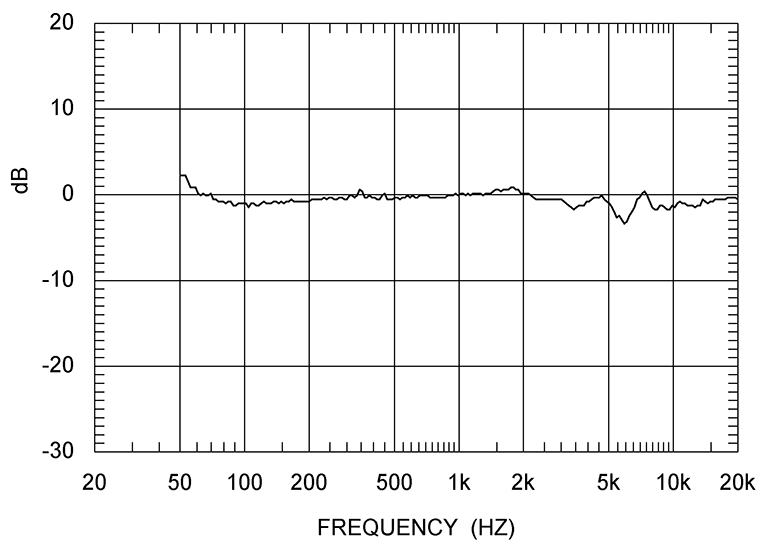
From around 3kHz up to 20kHz, where the AMT21CM2.1 tweeter is operating almost exclusively, the difference line is not even close to ideally linear, dipping below 0dB most of the time. In other words, the tweeter can’t properly output 95dB across all those frequencies. For example, while it produces close to 95dB at about 4.5kHz, where it almost touches the 0dB line, at about 6kHz its trace dips 3dB -- at 6kHz, it’s actually outputting only 92dB. Essentially, the AMT21CM2.1 struggled to reproduce a 95dB signal throughout its operating bandwidth.
Below 3kHz, where the PTT6.5W04 produces most of the SPK5’s output, the line indicates far more controlled behavior. Although that line is not always perfectly on the 0dB mark, it varies by only about 0.5dB to at worst 1.0dB.
Takeaway: Within the PTT6.5W04’s operating bandwidth, its performance remained excellent even under these brutal test conditions. No other speaker with a single, similarly sized midrange-woofer has exhibited such low distortion at so high an output level and remained that linear. As Purifi promised, their PTT6.5W04 driver can achieve excellent linearity and low distortion even at high output levels.
The completion of the Purifi measurement puzzle and the end of my quest . . . for now
This article will be published almost precisely 12 months after I first sat down with Peter Lyngdorf in Warsaw to talk about Purifi Audio. At the time, his enthusiasm for their products was obvious. That’s not something to be taken lightly -- in his career of more than 40 years, Lyngdorf has founded and/or owned some of the industry’s best-known and most influential companies. It was his enthusiasm that started me on my quest to research Purifi’s products and write this series of articles.
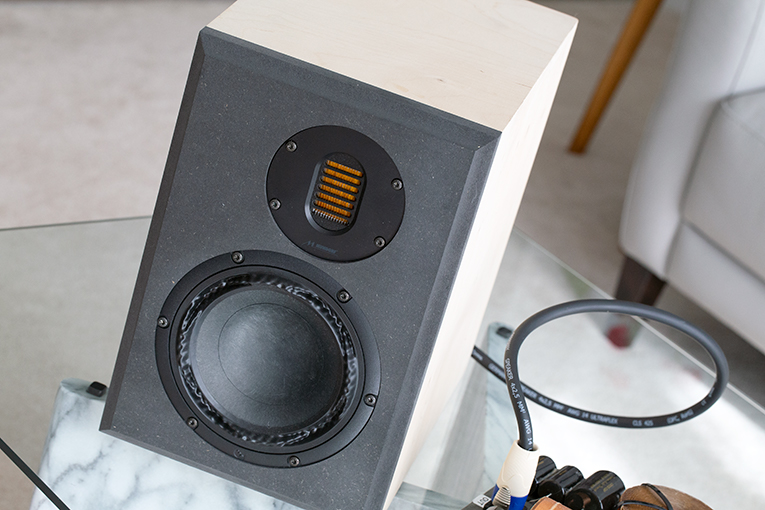
I’m glad I did. Based on what I heard from the Eigentakt amplifier and SPK5 loudspeaker, and our measurements of both, Purifi has developed groundbreaking products that can push hi-fi listening to greater heights for those who want sound free of coloration. And Purifi is doing so at OEM prices low enough to allow the companies that buy their products to use them in modestly priced commercial models. Check this link to see the prices of Purifi’s products -- for the performance they offer, they’re not expensive.
But Purifi’s products aren’t just great for the prices asked -- they’d be great at many times those prices. The more I listen to the Eigentakt and the SPK5s, the more impressed I am with their sound -- and I’ve been listening to them for months now. My journey of a year and four long feature articles may now be complete, but I can’t wait to see and hear whatever might come next from Purifi Audio, and whatever might compel me to begin another journey with them. It’s exciting to see that such levels of innovation and improvement can still happen in hi-fi.
. . . Doug Schneider
das@soundstagenetwork.com






















